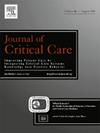肾替代治疗期间血管加压药的使用与死亡率的关系
IF 2.9
3区 医学
Q2 CRITICAL CARE MEDICINE
引用次数: 0
摘要
在需要肾脏替代治疗(RRT)的急性肾损伤(AKI)危重患者中,血管加压剂的使用是否与预后相关尚不清楚。我们研究了急性肾损伤(AKI)危重成人患者在RRT开始后血管加压药的使用与需要不同方式RRT的住院死亡率之间的关系。本观察性研究使用Premier Inc. (PINC) AI医疗保健数据库对2018年1月1日至2021年6月30日出院的美国医院AKI患者(n = 20,882)进行了观察性研究,这些患者需要持续RRT (n = 7660)和间歇性血液透析([IHD], n = 13,222)。提取RRT开始前3天和开始后3天的血管加压药使用数据。在接受CRRT治疗的患者中,rrt开始后血管加压药物暴露与经风险调整的住院死亡率显著相关(风险调整风险比[aHR], 1.69 95% CI: 1.55-1.85)和IHD (aHR, 1.72, 95% CI: 1.61-1.84)。与血管加压药物的数量相关的死亡风险增加。在CRRT患者中,死亡风险为:血管加压因子1 (aHR, 1.50;95% CI: 1.36-1.65), 2种血管加压药物(aHR, 1.94;95% CI: 1.76-2.14)和3种血管加压药物(aHR, 2.06;95% ci: 1.72-2.46)。同样,IHD患者的aHR为:血管加压因子1 (aHR, 1.57;95% CI: 1.47-1.68), 2种血管加压药物(aHR, 2.20;95% CI: 2.02-2.40)和3种血管加压药物(aHR, 2.32;95% ci: 1.82-2.96)。总之,在rrt开始后3天内血管加压素的使用与接受CRRT或IHD作为第一种治疗方式的患者较高的住院死亡率独立且逐渐相关。本文章由计算机程序翻译,如有差异,请以英文原文为准。
Association of vasopressor use during renal replacement therapy and mortality
Among critically ill patients with acute kidney injury (AKI) requiring renal replacement therapy (RRT) whether vasopressor use is associated with outcomes is unclear. We examined the association of vasopressor use following RRT initiation with in-hospital mortality in critically ill adults with AKI requiring different modalities of RRT. This observational study was conducted using the Premier Inc. (PINC) AI Healthcare Database of patients (n = 20,882) in U.S. hospitals with AKI requiring continuous RRT (n = 7660) and intermittent hemodialysis ([IHD], n = 13,222) with discharge from January 1, 2018, to June 30, 2021. Data on vasopressor use 3 days before and 3 days after RRT initiation were extracted. Exposure to vasopressors post-RRT initiation was significantly associated with risk-adjusted in-hospital mortality among patients treated with CRRT (risk-adjusted hazard ratio [aHR], 1.69 95 %CI: 1.55–1.85) and IHD (aHR, 1.72, 95 %CI: 1.61–1.84). There was an incremental risk of death associated with the number of vasopressors. Among CRRT patients, the risk of death were: 1 vasopressor (aHR, 1.50; 95 % CI: 1.36–1.65), 2 vasopressors (aHR, 1.94; 95 % CI: 1.76–2.14), and 3 vasopressors (aHR, 2.06; 95 % CI: 1.72–2.46). Similarly, for IHD patients, the aHRs were: 1 vasopressor (aHR, 1.57; 95 % CI: 1.47–1.68), 2 vasopressors (aHR, 2.20; 95 % CI: 2.02–2.40), and 3 vasopressors (aHR, 2.32; 95 % CI: 1.82–2.96). In summary, vasopressor use during the 3 days post-RRT initiation was independently and incrementally associated with higher in-hospital mortality in patients receiving either CRRT or IHD as the first modality.
求助全文
通过发布文献求助,成功后即可免费获取论文全文。
去求助
来源期刊

Journal of critical care
医学-危重病医学
CiteScore
8.60
自引率
2.70%
发文量
237
审稿时长
23 days
期刊介绍:
The Journal of Critical Care, the official publication of the World Federation of Societies of Intensive and Critical Care Medicine (WFSICCM), is a leading international, peer-reviewed journal providing original research, review articles, tutorials, and invited articles for physicians and allied health professionals involved in treating the critically ill. The Journal aims to improve patient care by furthering understanding of health systems research and its integration into clinical practice.
The Journal will include articles which discuss:
All aspects of health services research in critical care
System based practice in anesthesiology, perioperative and critical care medicine
The interface between anesthesiology, critical care medicine and pain
Integrating intraoperative management in preparation for postoperative critical care management and recovery
Optimizing patient management, i.e., exploring the interface between evidence-based principles or clinical insight into management and care of complex patients
The team approach in the OR and ICU
System-based research
Medical ethics
Technology in medicine
Seminars discussing current, state of the art, and sometimes controversial topics in anesthesiology, critical care medicine, and professional education
Residency Education.
 求助内容:
求助内容: 应助结果提醒方式:
应助结果提醒方式:


